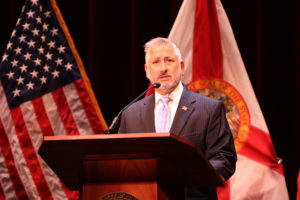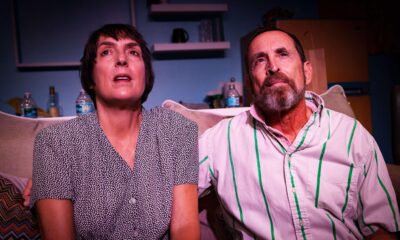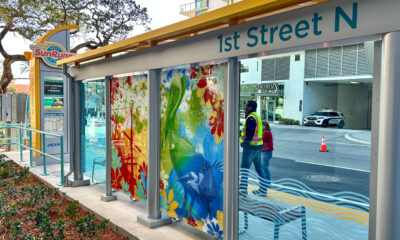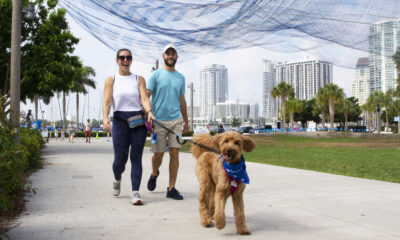As St. Pete looks toward 2050, visions of growth are evolving

It’s no secret that St. Petersburg is growing rapidly. With the completion of St. Pete’s tallest building, ONE, in 2018, it’s clear that the city is rising — and height is hot. The stark outline of ever-present cranes marks a city perpetually under construction.
“If you’re looking for St. Pete to be a sleepy retirement town with a hospitality-focused economy — keep looking,” St. Petersburg Mayor Rick Kriseman said bullishly in his State of the City address Saturday.

Mayor Kriseman gave his State of the City remarks at the Palladium Theater on Saturday.
Kriseman, who has billed himself as both progressive and pro-business, has made it clear that change will continue to come whether residents are ready or not, and that now is the time to begin planning for the coming decades.
A major focus of Saturday’s State of the City address was the announcement of a “generational endeavor” called Vision 2050. Currently, the city operates under Vision 2020, a guiding document for city development completed in 2002, nearly 17 years ago.
“The 2020 plan is what we’ve been operating under — our zoning, our regulations and all of our construction — everything is designed around that plan,” Kriseman told St. Pete Catalyst prior to his speech at the Palladium. “What is being built today is in response to what the public said they wanted when that plan was designed,” he explained.
A lot has changed in nearly 20 years. While St. Petersburg’s resurgence began in the ‘90s, marked by the revitalization of the historic Vinoy, the renaissance began to hit its stride after the Great Recession. Baywalk became the Sundial, restaurants began popping up along Central Avenue from the bay to Grand Central District and beyond. New apartment buildings have risen throughout the city. St. Pete is more built out than ever, and the forces of continued growth and development are not waning.
“In a built-out city like St. Pete, height and density are the only options on the table when it comes to growth,” Kriseman said.“It also happens to be a progressive approach. Unlike other cities, we are fortunate that we are not having divisive debates about sprawl and the elimination of green space.”
Instead of having a conversation about sprawl, St. Petersburg is having a conversation about preservation. Not just the preservation of buildings and architecture, but the preservation of what makes St. Pete special. The things that can’t quite be measured or regulated, the “you know it when you see it” type of cool that’s embodied in the city itself.
Words like height and density have long been a political third rail in St. Petersburg, where towers and high rises are regularly protested and rallied against as gentrifying forces, stripping St. Pete of its charm and identity. Opponents to such developments have argued that these proposed developments don’t blend with the predominant architecture of the city. Controversial projects like Bezu/Blue Lotus have been thwarted by the City Council, despite meeting specifications required by city code.
Kriseman tacitly warned against such actions, and argued that the conversation shouldn’t treat preservation and growth as mutually exclusive. “We can handle a tall building or two,” Kriseman said, “built planfully and according to a code and vision for our city that has served us well so far.”
“Our small businesses, our craft breweries, our art galleries, our murals, our music, our grittiness – those are the things that make St. Pete, St. Pete,” Kriseman said. “And I’m determined to keep it that way while also ensuring dynamic and much-needed growth — growth that includes height and density.”
“That’s why the [Storefront Conservation] Corridor program to me is really important as a step towards protecting what we’ve got right now while we lay out the 2050 plan, and lay out what the future is going to look like,” Kriseman told St. Pete Catalyst.
Kriseman publicly urged the City Council’s unanimous approval of the Storefront Conservation Corridor program Saturday. But behind the scenes, he also confirmed his support for changes to zoning and density regulations that will move through the City Council in the coming months, as well as the continued possibility of imposing linkage fees on development.
The City City Council’s Budget, Finance and Taxation Committee voted in September 2018 to seek proposals for a study on the potential impact of linkage fees, a practice used in cities throughout the country to boost affordable housing funds. Linkage fees generally charge a fee per square foot of market-rate development, and the funds collected go toward creating more affordable housing. Such fees could allow for the interests of growth to fund the interests of equity, or housing affordability, a best of both worlds scenario.
“We ought to do a linkage fees study, I think it’s really important… If you don’t charge enough, you’re really not accomplishing anything, you’re not creating a fund that’s going to actually do anything. But if you charge too much, then you really thwart development,” Kriseman explained. “What I’m hoping the study will tell us, is this a direction we should really be looking really hard at. If so, what’s the sweet spot?”
For now, the City of St. Pete is gearing up to get residents involved in the Vision 2050 planning, though a timeline has not yet been finalized.
“We want to take full advantage of interactive technology and new platforms available to us to create not just a guiding document, but a constructive conversation,” said Kriseman. “We want and need to hear from you.”
Visit StPete2050.com to share your ideas for St. Pete’s future.








Chris Tully
March 2, 2019at9:34 am
I would like to see more use of iconic historic buildings in conjunction with the vertical growth. Utilize historic architectural integrity into SOME of the new architecture….looking towards the future with a knod at our past. Our
Stephanie Rapko
February 28, 2019at3:48 pm
He is not on the resident’s side. All the Major is looking to do is build, build, build at the cost of pushing middle income and others, out of this City . He has literally sold property to the highest bidder leaving those on pensions, social security or otherwise with no place to go. l There is absolutely no affordable housing remaining and the ones still in existence have a waiting list of 3 years or more. Mayor get your head out of your money pocket and other areas, and make this a City for ALL people not just the people with money! It is horrible what you are doing!!!!!
Michael Bronson
February 28, 2019at9:44 am
Density and centralization are key to promoting more pedestrian and mass transit, but sustainability and green engineering must be a primary consideration in any new construction. We Floridians love our sunshine, parks and waterfront. We have fought for and will continue to fight for our Commons, which I hope the Mayor understands and supports.
Cassandra Lester
July 17, 2019at5:51 am
We are no longer the sunshine city. Under Rick Kriseman’s leadership (w/city council) we are NOW the CEMENT City and we block out sunshine with high rises! 😞